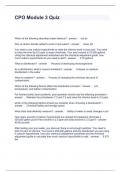Summary
Summary A* content for Functions of Congress: Representation, Legislation, and Oversight
Dive into the essential roles of Congress—Representation, Legislation, and Oversight—with this concise and insightful study guide. Perfect for students, educators, and politics enthusiasts, this resource unpacks the complexities of American governance with real-world examples and critical analy...
[Show more]













